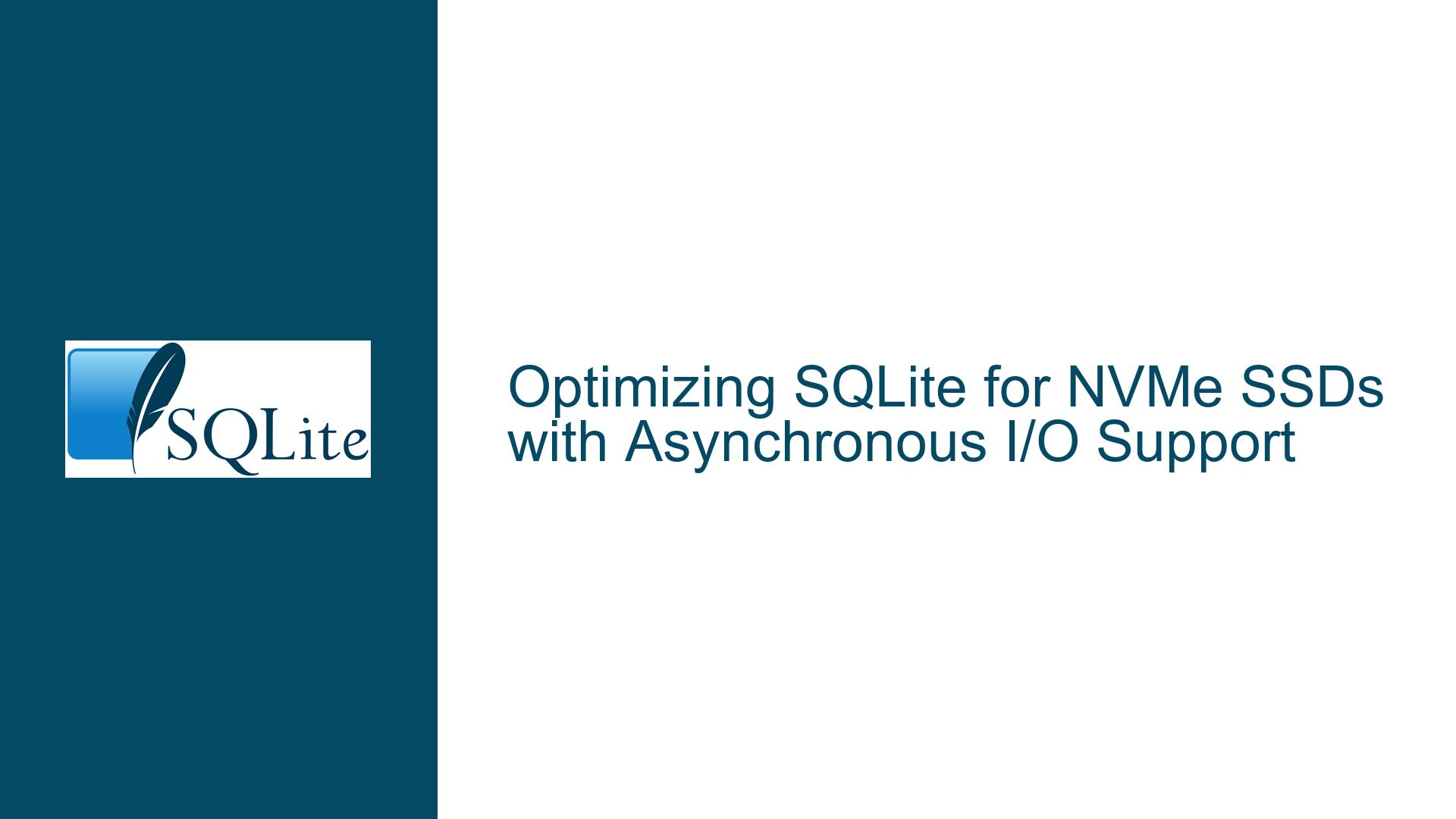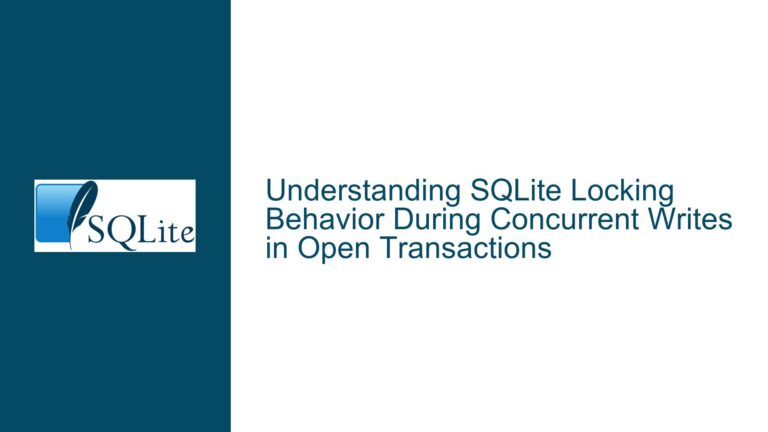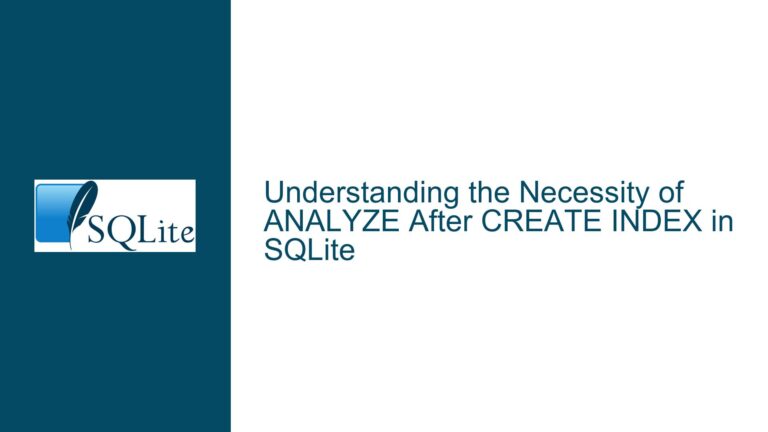Optimizing SQLite for NVMe SSDs with Asynchronous I/O Support
Understanding SQLite’s Synchronous I/O Behavior and Its Impact on NVMe SSDs
SQLite is a widely used embedded database engine known for its reliability, simplicity, and portability. One of its key features is the ability to control the level of synchronization between the database and the underlying storage system using the PRAGMA synchronous command. When set to FULL or EXTRA, SQLite ensures that every write operation is immediately flushed to the storage device, guaranteeing data integrity even in the event of a system crash. This is achieved through a combination of write(2) and fsync(2) system calls, which force data to be written to the physical storage medium.
However, this synchronous I/O behavior can lead to performance bottlenecks, particularly on modern NVMe SSDs. NVMe (Non-Volatile Memory Express) SSDs are designed to handle a high degree of parallelism, with multiple queues and thousands of outstanding I/O requests. When SQLite enforces synchronous I/O, the I/O depth is effectively reduced to one, serializing all write operations. This negates the inherent parallelism of NVMe SSDs, resulting in suboptimal performance. For example, benchmarks have shown that certain workloads, such as fillrandom from the db_bench_sqlite3 tool, perform slower on high-end NVMe SSDs like the Samsung 980 Pro or WD SN850 compared to older SATA SSDs like the Intel S4510 when synchronous I/O is enabled.
The core issue lies in the mismatch between SQLite’s synchronous I/O model and the highly parallel architecture of NVMe SSDs. While synchronous I/O ensures data integrity, it does so at the cost of performance, especially on storage devices that thrive on concurrent I/O operations. This raises the question: Can SQLite be modified to support asynchronous I/O, thereby better utilizing the capabilities of modern NVMe SSDs?
Exploring the Feasibility of Asynchronous I/O in SQLite
Asynchronous I/O (AIO) is a mechanism that allows I/O operations to be initiated and completed independently of the main program flow. This enables multiple I/O operations to be in flight simultaneously, which is ideal for leveraging the parallelism of NVMe SSDs. In the context of SQLite, implementing AIO could potentially improve performance by allowing the database engine to issue multiple write requests concurrently, rather than waiting for each one to complete before starting the next.
One approach to implementing AIO in SQLite is to use existing Linux AIO frameworks such as libaio or io_uring. libaio is a traditional AIO library that provides functions like io_submit(2) and io_getevents(2) for submitting and retrieving I/O operations. io_uring, on the other hand, is a newer and more efficient AIO framework that reduces the overhead of system calls by using shared memory rings for communication between the application and the kernel.
However, integrating AIO into SQLite is not straightforward. SQLite’s Virtual File System (VFS) layer is designed around synchronous I/O, and its current architecture assumes that I/O operations are completed in the order they are issued. This poses a challenge for AIO, where I/O operations can complete in any order. Additionally, SQLite relies on fsync(2) to ensure that all pending writes are flushed to disk, which is inherently a synchronous operation. While libaio and io_uring support asynchronous versions of fsync(2), their behavior and performance characteristics are not well-documented, and their use in a database context is largely unexplored.
Another consideration is the trade-off between performance and data integrity. While AIO can improve performance by allowing concurrent I/O operations, it also introduces complexity in ensuring that all writes are properly synchronized. For example, if a crash occurs while multiple asynchronous writes are in flight, the database may be left in an inconsistent state. This makes it crucial to carefully design the AIO implementation to maintain SQLite’s strong guarantees of data integrity.
Implementing Asynchronous I/O in SQLite: Steps, Solutions, and Fixes
To address the performance limitations of synchronous I/O on NVMe SSDs, SQLite could be extended to support asynchronous I/O through the following steps:
Modify the VFS Layer to Support Asynchronous Operations: The first step is to extend SQLite’s VFS layer to support asynchronous I/O operations. This involves adding new methods for submitting and retrieving I/O requests asynchronously, as well as modifying existing methods to handle out-of-order completion. The VFS layer would need to be updated to work with AIO frameworks like
libaioorio_uring, including support for asynchronous versions offsync(2).Integrate AIO Frameworks: Once the VFS layer has been extended, the next step is to integrate an AIO framework such as
libaioorio_uring. This involves implementing the necessary glue code to interface between SQLite’s VFS layer and the AIO framework. For example, when a write operation is issued, the VFS layer would submit the request to the AIO framework usingio_submit(2)orio_uring_submit(2). The VFS layer would then periodically check for completed I/O operations usingio_getevents(2)orio_uring_peek_batch(2).Ensure Data Integrity with Asynchronous fsync: One of the key challenges in implementing AIO in SQLite is ensuring data integrity. While AIO can improve performance, it must not compromise SQLite’s guarantees of data durability. To address this, the VFS layer would need to implement a mechanism for ensuring that all pending writes are flushed to disk before returning from a commit operation. This could involve using asynchronous versions of
fsync(2)provided bylibaioorio_uring, or implementing a custom synchronization mechanism that ensures all I/O operations are completed before proceeding.Optimize for NVMe SSDs: To fully leverage the capabilities of NVMe SSDs, the AIO implementation should be optimized for high I/O depth and parallelism. This includes tuning the number of concurrent I/O requests, optimizing the I/O submission and completion paths, and minimizing the overhead of context switches and system calls. Additionally, the implementation should take advantage of NVMe-specific features such as multiple queues and hardware offloading.
Benchmark and Validate the Implementation: Finally, the AIO implementation should be thoroughly benchmarked and validated to ensure that it delivers the expected performance improvements without compromising data integrity. This involves running a variety of workloads on different storage devices, including NVMe SSDs, SATA SSDs, and traditional hard drives, to measure the impact of AIO on performance and reliability. The results should be compared against the existing synchronous I/O implementation to quantify the benefits of AIO.
By following these steps, SQLite could be extended to support asynchronous I/O, enabling it to better utilize the capabilities of modern NVMe SSDs. This would not only improve performance for high-concurrency workloads but also ensure that SQLite remains a viable option for applications that require both high performance and strong data integrity guarantees.






